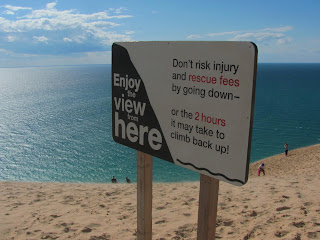Sleeping Bear Dunes
During the week that Al and I stayed at a fishing resort on the Betsie River, we were able to explore the Sleeping Bear Dunes National Seashore by car and by bicycle too. Sleeping Bear Dunes is located along the eastern coastline of Lake Michigan. It comprises about 35 miles of the coast, including the famous dunes, beaches, abandoned farms, a historic village and dense forests of mixed hardwood and evergreen trees.
There were many wonderful bike trails
throughout the park. One graveled trail wound through a portion of the Port
Oneida Historic Farm district—sixteen old, weathered homes and barns built in
the 1860’s. Besides providing for their own needs, farmers sold wood, produce
and maple sugar to the various ships coming along the coast. After coal
replaced wood for fuel on steamships the economy slowed down. That, along with
the severe weather conditions, eventually caused families to leave their farms
and move elsewhere.
Not far away was the little village of Glenn
Haven that existed during the same era, from 1865-1931. It was also a place
where steamships could dock and resupply with wood. We drove a short distance
off the main highway to see the tiny village consisting of an inn, general
store, blacksmith shop and the hulk of an old ship now used as a museum and
visitor’s center.
Another jaunt took us around a seven mile
loop, called the Pierce Stocking Scenic Drive. This was named after a local
resident and lumberman who wanted to provide a road through the bluffs and
dunes so that tourists as well as local inhabitants could enjoy the beauty of
the area without destroying the fragile dunes. The loop was finished in the
1960’s and later became part of the national park.
Along the drive were about a dozen places to
stop, sit down at a picnic table and enjoy the view. Al and I followed a guided
map and signs that explained what the focal point of interest was at each
place. At one parking area which accessed a wooden walkway and overlook out to
Lake Michigan, the dunes formed a very steep cliff sloping right down to the
water’s edge where some tiny figures on surfboards were enjoying the water.
Scores of people walking along the wooden
walkway at the top of the plateau passed by a large sign on which were printed
these words in striking bold print: “Enjoy the view from here. Don’t risk
injury and rescue fees by going down—or the two hours it may take to climb back
up!”
It only took about ten or fifteen minutes
for able-bodied people and youth to descend the steep slope of sand which Al
estimated to be about 700 feet high at a sixty degree angle! However coming
back up was a different story. Hikers had to battle sliding backwards on the
sand as well as a strong wind blowing up and over the dunes, making it hard to
breathe and see. While it looked tempting to try and the way down seemed easy
and lots of fun, the return trip was definitely very difficult.
We heard that people have to be rescued from
that steep place all of the time. So why don’t they pay attention to the
warning on the sign? What is it in humans that make us think that we are exempt
from certain safety rules or that nothing could ever happen to us? Al and I
stayed up on the bluffs like the sign advised; however, I have the same
problem. With age I’ve become more cautious and careful to follow rules set up
for my own personal safety.
This propensity to break rules reminds me of
our stubbornness when it comes to admitting that God knows what is best for us
and then following His commands. As the salmon fisherman who was staying in the
cabin next door to us put it, “I know what He wants me to do. It’s just a
matter of doing it!” Sad but true!
“Show me your ways, oh Lord, teach me your
paths; guide me in your truth and teach me, for you are God my Savior, and my
hope is in you all day long.” Psalm 25:4-5 NIV





.jpg)

Comments
Post a Comment